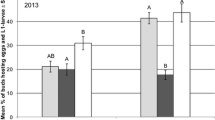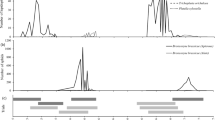Abstract
In this study, the effect of the four different insecticides Karate Zeon (a.i. lambda-cyhalothrin), Elado (clothianidin + beta-cyfluthrin), Fortenza Force (cyantraniliprole + tefluthrin) (only 2015), and Lumiposa (cyantraniliprole) (only 2016 and 2017) on the insect autumn pests Delia radicum, Psylliodes chrysocephala, and aphids (mainly Myzus persicae) and Turnip Yellows Virus in winter oilseed rape was investigated in 3 years of field trials. The results showed that the effects of the Elado seed treatment on P. chrysocephala depend on the time of migration of adults. Due to delayed immigration of beetles into the field in 2015/2016 and 2017/2018, there was no clear effect of the seed treatment on the number of larvae per plant. In contrast in 2016/2017, the beetles colonized the crop in early September, and the number of larvae was significantly reduced by Elado. Cyantraniliprole and clothianidin seed treatments seem to support crop emergence independent of insect pests assessed. Spraying of the pyrethroid Karate Zeon in autumn significantly decreased the number of larvae in all years. Also the number of next-generation beetles was significantly reduced only by Karate Zeon. In all years, the aphid infestation was significantly reduced only by Elado seed treatment. The infection rate by TuYV was very high in all years and only slightly reduced by Elado seed treatment. There was only minimal occurrence of Delia radicum in all years. Cyantraniliprole products did not show any influence on the assessed insect pests in all years. There was no significant effect of any treatment on yield, but in 2015/2016 and 2016/2017, the highest yield was obtained in the Elado seed treatment.

Similar content being viewed by others
References
Alford DV, Nilsson C, Ulber B (2003) Insect pests of winter oilseed rape crops. In: Alford DV (ed) Biocontrol of oilseed rape pests. Blackwell Science, Oxford, pp 9–41
Baroso JM (2013) Commission implementing regulation (EU) no 485/2013 of 24 May 2013. Off J Eur Union 139:12–26
Bonnemaison L, Jourdheuil P (1954) L’altise d’hiver du colza (Psylliodes chrysocephala L.). Annales des Épiphyties 4:345–524
Clark MF, Adams AN (1977) Characteristics of the microplate method of enzyme-linked immunosorbent assay for the detection of plant viruses. J Gen Virol 34:475–483
Dewar AM (2017) The adverse impact of the neonicotinoid seed treatment ban on crop protection in oilseed rape in the United Kingdom. Pest Manag Sci 73:1305–1309. https://doi.org/10.1002/ps.4511
Ellis S (2015) Maximising control of cabbage stem flea beetles (CSFB) without neonicotinoid seed treatments. AHDB project report no. 546
EPPO, European and Mediterranean Plant Protection Organization (2001) Psylliodes chrysocephala: PP 1/73(3); EPPO Standards PP1. 2nd edn, vol 3, pp 95–97
EPPO, European and Mediterranean Plant Protection Organization (2007) Delia radicum on oilseed rape: PP 1/259 (1). EPPO Bull 37:491–494. https://doi.org/10.1111/j.1365-2338.2007.01155.x
Godan D (1950) Über die Wirkung des Rapserdflohlarven-Befalls auf die Rapspflanze. Mitteilungen aus der Biologischen Zentralanstalt für Land- und Forstwirtschaft, Berlin-Dahlem (69)
Godan D (1951) Über den Einfluß hoher und tiefer Temperaturen auf die Entwicklungsstadien des Rapserdflohs (Psylliodes chrysocephala L.). Zeitschrift für Pflanzenbau und Pflanzenschutz 45:169–178
Heimbach U, Brandes M (2016) Pyrethroid resistance of insect pests in oilseed rape in Germany since 2005. IOBC WPRS Bull 116:17–22
Heimbach U, Eggers C, Thieme T (2002) Aphids in oil seed rape in autumn possibilities to reduce virus transmission. IOBC-WPRS Bull 25:123–131
Heimbach U, Brandes M, Conrad N, Ulber B (2016) Would more data on the population dynamics of insect pests in oilseed rape support better decision support in IPM? IOBC WPRS Bull 116:43
Hoßfeld R (1993) Die Gelbschale als Entscheidungshilfe bei der Bekämpfung des Rapserdflohs (Psylliodes chrysocephala L.) [The use of yellow water dishes as a decision aid for the control of Psylliodes chrysocephala L.]. Gesunde Pflanzen 45:291–295
IRAC, Insecticide Resistance Action Committee (2012) Major mechanisms of insecticide resistance in green peach aphid Myzus persicae Sulzer. http://www.irac-online.org/GGTSPU-styx2.jki.bund.de-14674-10611698-Ea9bIevl0viUUoo5-DAT/content/uploads/myzus_r_mechanisms_poster_v8.4_14March12.pdf. Accessed 1 Nov 2017
Johnen A, Meier H (2000) A weather-based decision support system for managing oilseed rape pests. Br Crop Prot Conf Pests Dis 2000:793–800
Kaufmann O (1941) Zur Biologie des Rapserdflohs (Psylliodes chrysocephala L.). Z Pflanzenkr Pflanzenschutz 51:305–324
Mathiasen H, Sørensen H, Bligaard J, Esbjerg P (2015a) Effect of temperature on reproduction and embryonic development of the cabbage stem flea beetle, Psylliodes chrysocephala L., (Coleoptera: Chrysomelidae). J Appl Entomol 139:600–608. https://doi.org/10.1111/jen.12201
Mathiasen H, Bligaard J, Esbjerg P (2015b) Survival of cabbage stem flea beetle larvae, Psylliodes chrysocephala, exposed to low temperatures. Entomol Exp Appl 157:220–226. https://doi.org/10.1111/eea.12351
Nilson C (2002) Strategies for the control of cabbage stem flea beetle on winter rape in Sweden. IOBC WPRS Bull 25:133–139
Nilsson C (1990) Yield losses in winter rape caused by cabbage stem flea beetle larvae (Psylliodes chrysocephala (L.)). IOBC WPRS Bull 13:53–56
Noleppa S (2017) Banning neonicotinoids in the European Union: An ex-post assesment of economic and environmental costs: HFFA research paper 01/2017
Nuss H (2004) Einfluss der Pflanzendichte und –architektur auf Abundanz und innerpflanzliche Verteilung stängelminierender Schadinsekten in Winterraps. Dissertation, Georg-August-Universität Göttingen
Purvins G (1986) The influence of cabbage stem flea beetle (Psylliodes chrysocephala L.) on yields of oilseedrape. Br Crop Prot Conf Pests Dis 1986:753–759
Schliephake E, Graichen K, Rabenstein F (2000) Investigations on the vector transmission of the Beet mild yellowing virus and the Turnip yellows virus. Z Pflanzenkr Pflanzenschutz 107:81–87
Schott H (1959) Epidmiologie des Rapserdflohes (Psylliodes chrysocephala L.). Dissertation, Humboldt—Universität zu Berlin
Schulz R-R (1983) Zur Biologie, Ökologie und Schadwirkung des Rapserdflohs (Psylliodes chrysocephala L.) an Winterraps (Brassica napus L. oleifera Metzg.). Dissertation, Wilhelm-Piek-Universität Rostock
Stevens M, McGrann G, Clark B (2008) Turnip yellows virus (syn Beet western yellows virus): an emerging threat to European oilseed rape. HGCA Res Rev 69:36
Acknowledgements
Thanks to all students and research assistants for their work in the field and laboratory. Thanks to UFOP (Union for Promoting Oil and Protein Plants e.V.) for financial support.
Author information
Authors and Affiliations
Corresponding author
Ethics declarations
Conflict of interest
The authors declare that they have no conflict of interest.
Rights and permissions
About this article
Cite this article
Conrad, N., Brandes, M., Will, T. et al. Effects of insecticidal seed treatments and foliar sprays in winter oilseed rape in autumn on insect pests and TuYV infection. J Plant Dis Prot 125, 557–565 (2018). https://doi.org/10.1007/s41348-018-0173-5
Received:
Accepted:
Published:
Issue Date:
DOI: https://doi.org/10.1007/s41348-018-0173-5




